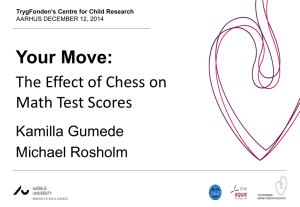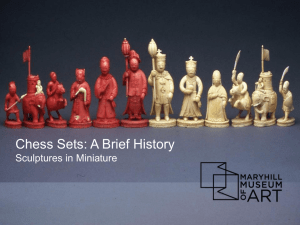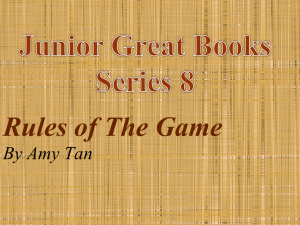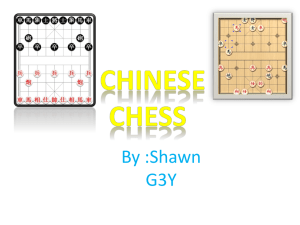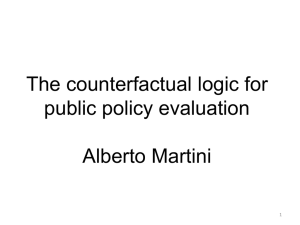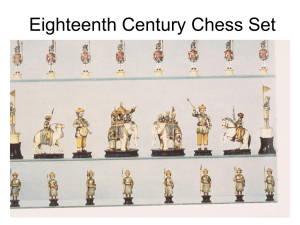Schaken en autisme
advertisement
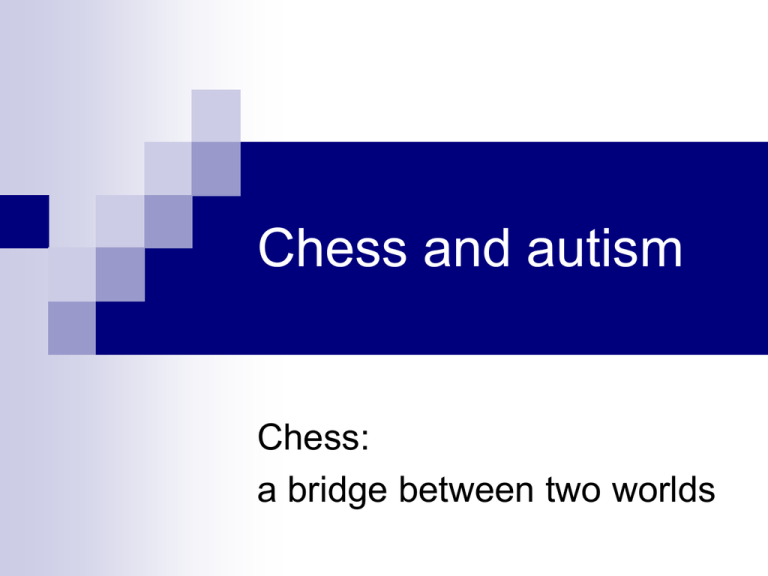
Chess and autism Chess: a bridge between two worlds Introduction Karel van Delft - Psychologist Chess trainer Journalist - www.kvdc.nl www.schaaktalent.nl www.chesstalent.com www.schaken-en-autisme.nl - karel@kvdc.nl - Talent development and autism Interested in development of talent. Talent is innate possibility to develop skills. Developed skill brings: performance, succes and fun. Questions: How to develop talent. Which are conditions to learn and train. Which are conditions to perform. Conclusions Chess fits autistic children and adults. Chess stimulates the cognitive, social and emotional development. Chess brings a bridge between two worlds. Chess stimulates Cognitive development Thinking, reasoning Social development Contacts with others, social skills Emotional development Selfconfidence, pleasure Why chess fits autists Not physical Logical Safe Structured Quiet Needs of autistic kids Rest, structure, obvious rules Safe environment Predictable procedures Clear, concrete communiction Acceptation, empathy Trix Meurs, mother of Tom Trix Meurs presenta su cartel La idea mía es, que los niños con autismo (normalmente) están enfocados. El contacto con autistas es a menudo comparado con un buzón de correo, puede entrar algo, si el buzón tiene al menos una abertura, o puede salir algo, pero no simultáneamente. Esta última es una condición para reciprocidad, intimidad y sexualidad. Ser uno mismo y al mismo tiempo poder trasladarse a otra persona. Junto con ese enfoque, hay oportunidades para aprender habilidades, lo que he escrito aquí. Un enfoque básicamente puede ser cualquier cosa, ajedrez, pintura, música, horarios de los autobuses, el aeropuerto, juegos de ordenador, juguetes que dan vueltas, el tambor de la lavadora, etc. La idea es que usted y el niño, entren en el mundo enfocado del niño con el objetivo final de aprender, así el lenguaje y la fascinación pueden descubrirse. Dentro de esos ejercicios, el buzón de correo puede abrirse un poco más o durante mas tiempo. El niño requiere seguridad y confianza para conectar habilidades al enfoco o el desarrollo cognitivo. Para compartir el enfoque se necesitan dos, un conjunto, así con tiempo se puede crear un enlace, un intercambio entre dos líneas. Y,... cada cambio es uno. Luego, en el campo de los enfoques se puede ir practicando, me refiero por ejemplo al ajedrez, o jugando en una habitación con otras personas. Entrenarse en la casa del entrenador. Y a continuación, expandir ... Decir hola y adiós, cuando vienen o van. Ofrecerle una bebida a su oponente después de una partida y darle las gracias. El siguiente paso puede ser una charla, o comer en la cafetería o restaurante. Pasar la noche en otro sitio. A veces en una casa compartida con los demás. Aceptar tanto una victoria como una pérdida. Para nosotros quizá habilidades simples, pero para los niños con autismo, puede que cada vez sea un importante obstáculo que deben superar. Esto requiere coraje y superación de miedos, y romper con algunas costumbres. Cada niño y joven con autismo, por supuesto tiene un límite a lo que se le puede introducir. "Un techo en la casa" del conocimiento y el coraje. Un desafío de mucho amor para padres y entrenadores See the hand out for the text in which Trix Meurs explains her poster. As a mother of two autistic sons she knows autists focus. Via this focus you can get contact with them. Purpose of this lecture Understanding of aspects connected with chess and autism. Practical ideas of how to use chess for stimulating the development and emancipation of autistic youth. This is a story about Tom Maarten Jaap Caspar Laurens Jeroen And many more autistic children and adults. Understanding They have problems understanding the world around them. People around them have difficulties to understand them. Results: misunderstandings, confusion, fear and frustrations. What is autism? Autism is a congenital neurological disorder. Symptoms are: limited social skills, a need for structure, and problems with emotions, empathy, self-image, language, imaginative powers and locomotion. Autists have trouble internalizing sensory stimuli as a coherent whole. Autists often have a limited field of interest, in which they can specialize strongly. To cope with the complexities of the outside world, autists seek refuge in fixed habits and patterns. We speak of the Spectrum of Autism Disorders. Category classifications are: classical autism, MCDD (Multiple Complex Development Disorder), the Asperger’s Disorder, and PDDNOS (Pervasive Developmental Disorder Not Otherwise Specified). Prevalence Approximately one in every 100 persons has an autistic disorder. Boys suffer from it six times more frequently than girls. Environment The better their environment is geared to their needs, the more autists will be able to develop their qualities. How to recognize autism (1) Rigid behaviour, ‘strange’ Difficult normal contact No eye contact Very sensible for sensory stimuli Often alone More difficulties playing with other kids, compared with adults Language often different How to recognize autism (2) Mood can change fast Dealing with changing circumstances is difficult Fear, panic attacs, depressions Sometimes difficulties with futilities Not predictable Pure, friendly Incomprehensable Limitations youth with autistic disorder (1) Social skils limited: no or a few friendships Communication, language Non-verbal communication Imagination Need for structure Emotions, empathy, fears Self-image Limitations youth with autistic disorder (2) Locomotion Internalizing sensory stimuli Concentration Physical contact threatening Limited field of interest Changing situations But: No autist is the same Different types of autism Level of disorder Nature – nurture Innate character Intelligence Special talents Upbringing Social circumstances Movie: With autism you can participate in a chess training and tournament ‘Everything in the life of Laurens should be planned’, his mother says. ‘Except for chess. Then he likes to investigate.’ You can influence level of performance Create conditions: Talent: innate abilities can be improved. Circumstances: good trainer, materials. Motivation: grows by succes experiences. Physical condition: improved by excercises. Mental condition: created by respect, empathy. Strong aspects of autists (1) Own logic, system thinker Can concentrate well on one topic Can work concentrated a long time Understands well schematical representations Has a strong visual memory Works well by him self Strong aspects of autists (2) Is polite to others Is reliable (agreement is agreement) Works well via plans and procedures Can reproduce many facts Has eye for details Has much knowledge about certain issues First article about chess and autism in Magazine Dutch chess federation KNSB Translation in English, f.e. India Translation in Spanish, f.e. Mexico More in Spanish, just google Spanish translation initiative by German Chessbase Jaap de Vries Jaap and his Nintendo Jaap has Asperger. Between rounds in a chess tournament, Jaap plays games on his Nintendo. This is precisely what does allow him to make contact with other children, who come to him to see what game he is playing. ‘If you share his interest, he is open for contact’, his mother Annemieke has noticed. Maarten Beekhuis at his chess club Quotes Maarten ‘I think that I like chess because I am good at it.’ ‘I’m probably more self-involved than most people, but I like to have social contacts. My autism makes this difficult’.’ Tom Meurs with trainer IM Merijn van Delft. At the moment they play in the same team of Homburg Apeldoorn in the highest Dutch chess league. Quotes Tom About chess: It is a strategic game. It offers you a full scope to apply all your understanding and your creativity. You really have to work hard; analyze, make plans, look deeper than your opponent.’ ‘A kid with Asperger’s who is enthusiastic can do a lot more. Such kids should be allowed to go ahead.’ Principles of emancipation Everyone has limitations and disabilities. We have to make the best of it. If possible: together. Speak about limitations. Create conditions for discussion about it. No shame. Perspective Autism can not be cured You can learn to deal with it There is room for development of personal qualities Autists and people around them can learn to deal with handicaps Important: recognize and accept limitations Talk with autist in a normal way Perspectives of better life quality via Behaviour therapy Psycho education Medical treatment Creating predictable circumstances And: Join activities like chess to stimulate qualities Chess is about: combining rules and patterns Qualifications of a trainer Know chess (limited level already enough) Empathy Didactical skills Understanding autism Social skills How to develop as a trainer Read, talk, get experiences Understanding, expertise, patience Consistent attitude and procedures Offer structure and make this clear For example via week schedule Personal contact Small groups Principles for a trainer Start with possibilities of autists, f.e. intelligence, eye for detail, strong memory, possibility to focus. Give own responsibility where possible and help where necessary. Be practical Be practical if there arise difficulties. For example make agreement with autistic kid and group you give him a ‘time out’ if he gets very angry or panics. Time out is not a penalty, it is a practical solution. Because: if somebody has a headache he also needs some rest. Ask the kid why he shows this behaviour. Maybe things can be done different next time. How to develop skills as a trainer or coach You can learn how to teach, it is a skill. You are not aware about a problem. You realize the problem. You deal with problem conscious. Skill becomes automatism. Tips of trainers (1) Small groups, individual attention Unambigious use of language Quiet environment Enough time for tasks, avoid stress Announce clearly what you will do Immediately interfere when problems arise Mention wrong behaviour and explain why Tips of trainers (2) Useless to get angry, tell what you expect Clear structure in lessons and programm Don’t stop fast self study (Aspergers) Emotional support, explain situations Check always if the kid understands what you are saying Watch the situation by the eyes of a autist How can you train and improve your chess Play games. Analyze games together and with a chess computer programm like Fritz. Tactics study via Step methods. Study commented games (with comments in variations and words). You need a board, pieces. For a game also a clock. On the internet is much gratis information. For a lot of information about how to train, see also the book Developing Chess Talent: www.chesstalent.com How to train chess tactics Steps method (www.stappenmethode.nl) Structured method with introduction and exercises on each topic (circa 100) In books, but also on dvd Advantage: direct feedback Advantage: self study possible Cheap: circa fifteen euro Step method: very structured method With explication And excercises (with direct feedback) Play and analyze with programm Fritz How and where can you train Self study On a club Via the computer and internet With friends and family With a qualified trainer There are a lot of nice chess books. You can play a game with a pupil, annotate it and discuss it afterwards. 15 year old pupil, gets individual lessons, says I learned: Persistance Taking into account different things at the same time Knowledge and technique of chess More pleasure in the game Proud because I win more often Dealing with loosing a game Concentration on a task Doing research Discussion with another about Verbalizing matters Self study Caspar Hermeling (Asperger) became a youth chess coach himself, movie at www.schaken-en-autisme.nl Conclusions Chess fits autistic children and adults. Chess stimulates the cognitive, social and emotional development. Chess brings a bridge between two worlds.
